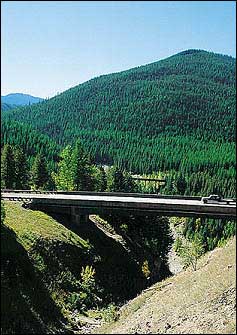















Successes in Stewardship: November 2004 |
|---|

|
Federal Highway Administration
November 2004
Integrated Planning: Working to Combine Different Needs and Strategies

The Federal Highway Administration (FHWA) and other Federal agencies support an ecosystem approach to infrastructure development. However, successfully implementing national standards at the state and local levels — where infrastructure projects are carried out — presents a myriad of challenges.
The ecosystem approach is characterized as a method for sustaining or restoring natural systems and their functions and values. Based on a collaboratively developed vision that integrates ecological, economic, and social factors, it is applied within a geographic framework defined primarily by ecological boundaries. While agency professionals involved in transportation planning, design, review, and development are eager to balance infrastructure needs with conservation strategies, they may lack the tools to work together toward ecosystem management. Many are recognizing the need for comprehensive planning that integrates the conservation strategies and infrastructure needs of all stakeholders — linking transportation planning with the planning activities of resource agencies and land management agencies, as well as with local planning organizations.
Integrated planning can help agencies to identify opportunities to address environmental impacts early in project development and to develop mitigation options that address the highest-priority needs in an ecosystem. The key characteristics of integrated planning include:
Because it enables cooperative problem solving among government agencies, public entities, and private groups or individuals, integrated planning can mitigate some of the challenges that agencies often face such as:
Integrated planning ensures that the needs and concerns of all participating stakeholders are addressed, enabling more predictable development and conservation outcomes.
|
Integrated Planning Efforts and Resources
Every two years, the Center for Transportation and the Environment hosts the interagency International Conference on Ecology and Transportation, which discusses research results, applications, and best practices that improve the way ecological concerns are considered in surface transportation programs. Useful Resources and Practices |
In 2003, when Executive Order 13274, Environmental Stewardship and Transportation Infrastructure Review, was issued, an Interagency Task Force to promote environmental streamlining and stewardship was created. FHWA leads the Executive Order Interagency Task Force efforts and has a prominent role in the Task Force Working Group on Integrated Planning, which meets frequently to discuss integrated planning barriers, priorities, and progress. The Working Group has identified key issues and is developing a broad range of recommendations for helping agencies move toward integrated planning.
In addition to the Task Force, FHWA is partnering with other Federal agencies to write a handbook for Federal field staff. The handbook steering committee is composed of representatives from the Environmental Protection Agency, US Army Corps of Engineers, US Fish and Wildlife Agency, Bureau of Land Management, National Park Service, US Forest Service, National Oceanic and Atmospheric Administration, State Departments of Transportation, and FHWA. Drawing on useful practices and lessons learned at the State and local levels — including the need for more and improved data sharing — the handbook will outline a collaborative, comprehensive approach to addressing the highest-priority needs in an ecological region. The handbook will provide step-by-step processes, tools, techniques, and resources to enable Federal staff to work in partnership with State, local, and non-profit organizations to initiate integrated planning and deploy creative approaches to mitigation.
To start applying the basic concepts of integrated planning, no changes to existing legislation or regulations are necessary. Cooperative partnerships among government agencies and other stakeholders are essential because each agency, district, office, and community has different concerns and resources. Collaborative partnerships and formal partnership agreements can help foster the trust necessary for planning effective environmental solutions. Once you determine what relationships to cultivate, what data are available, and what tools you and your partners have, you can begin to use locally available expertise and resources to identify projects that previously may have seemed too complicated to tackle.
|
Look What's New! · Tell us what you think! Help us improve the website · Submit new practices to the State Practices Database. You can now submit your own state streamlining practices to our database by visiting http://environment.fhwa.dot.gov/strmlng/es3stateprac.asp. |
Contact InformationCarol Adkins, FHWA400 Seventh Street SW Room 3222 Washington, DC 20590 (202) 366-2054 Carol.Adkins@fhwa.dot.gov |
|
